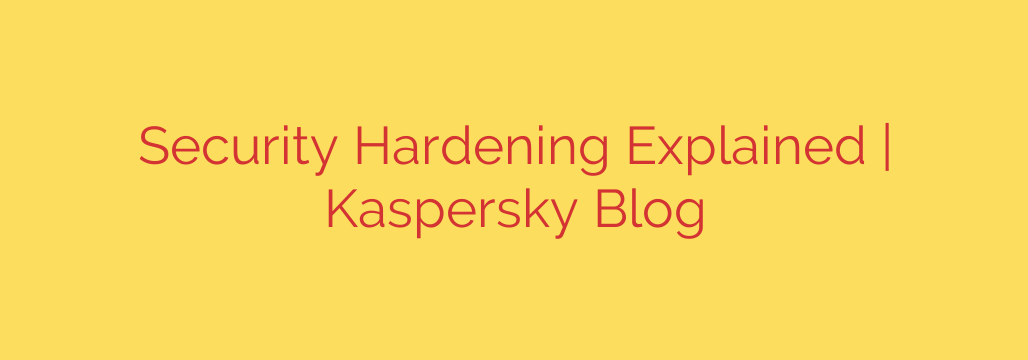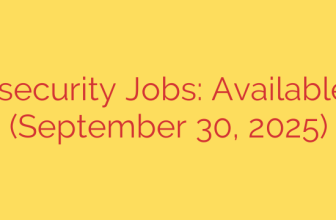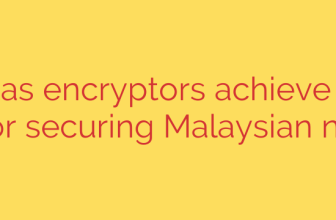
Security Hardening 101: Your Essential Guide to a Stronger Defense
In today’s digital landscape, cyber threats are more sophisticated than ever. Businesses and individuals alike face a constant barrage of potential attacks, from malware and ransomware to data breaches. While many security strategies are reactive, focusing on detecting threats as they happen, the most effective defense starts with a proactive approach: security hardening.
Security hardening is the process of systematically identifying and eliminating potential security vulnerabilities within your computer systems, networks, and applications. The core goal is to reduce your overall “attack surface,” which is the sum of all possible entry points an attacker could use to gain unauthorized access.
Think of it like securing a fortress. You wouldn’t just post a single guard at the main gate; you’d also reinforce the walls, bar the windows, and control every point of entry. In the digital world, security hardening applies this same comprehensive logic to your technology infrastructure.
Why is Security Hardening Crucial?
Implementing a robust hardening strategy isn’t just a technical exercise; it’s a fundamental business necessity. A hardened system provides several critical benefits:
- Drastically Reduced Risk: By closing security loopholes and removing non-essential software or services, you give attackers fewer opportunities to breach your defenses.
- Enhanced Data Protection: A secure system is the first line of defense in protecting sensitive company information, customer data, and intellectual property from theft or corruption.
- Simplified Auditing & Compliance: Many regulatory standards, such as PCI DSS and HIPAA, mandate strong security controls. A well-documented hardening process makes it significantly easier to demonstrate compliance and pass security audits.
- Improved System Stability: Removing unnecessary components and ensuring proper configuration can often lead to a more streamlined and reliable system with fewer potential conflicts.
Key Types of Security Hardening
Security hardening isn’t a single action but a multi-layered strategy that applies to different parts of your IT environment. Here are the most critical areas to focus on.
Server & Operating System Hardening
This is the foundation of your security posture. Servers and the operating systems (OS) they run are prime targets for attackers.
- Actionable Tip: Regularly apply security patches and software updates from vendors as soon as they become available. This is one of the most effective ways to close known vulnerabilities.
- Actionable Tip: Enforce the Principle of Least Privilege. This means every user, application, and system process should only have the absolute minimum permissions necessary to perform its function.
- Actionable Tip: Remove or disable all unnecessary software, drivers, and services. If a feature isn’t essential for the system’s purpose, it’s a potential liability that should be eliminated.
Application Hardening
Software applications, whether developed in-house or by a third party, often contain flaws that can be exploited.
- Actionable Tip: Secure your software development lifecycle by integrating security checks, such as static and dynamic code analysis, from the very beginning.
- Actionable Tip: Isolate applications from the underlying operating system using techniques like containerization to limit the potential damage if one is compromised.
- Actionable Tip: Disable unnecessary application features and ensure all default passwords are changed immediately upon installation.
Network Hardening
Your network is the communication backbone of your organization, making it a critical area to secure against unauthorized access and malicious traffic.
- Actionable Tip: Properly configure firewalls to block all non-essential ports and traffic. Your firewall rules should be based on a “deny-all” principle, only allowing traffic that is explicitly permitted.
- Actionable Tip: Secure remote access points. If you use VPNs or other remote access tools, ensure they use strong encryption and multi-factor authentication (MFA).
- Actionable Tip: Disable unused network protocols and ports on all network devices, including routers and switches.
Database Hardening
Databases often hold an organization’s most valuable information, making them a high-priority target for attackers.
- Actionable Tip: Control administrator privileges strictly. Limit who can access and modify database structures and data.
- Actionable Tip: Encrypt sensitive data both “at rest” (when stored in the database) and “in transit” (when moving across the network).
- Actionable Tip: Turn on robust logging and monitoring to track database access and activity, helping you detect suspicious behavior quickly.
The Bottom Line: A Continuous Process
It’s important to understand that security hardening is not a one-time project but an ongoing, cyclical process. New threats emerge daily, and systems change over time. Regular audits, vulnerability scanning, and consistent patch management are essential to maintaining a hardened state.
By embracing security hardening as a foundational element of your cybersecurity strategy, you move from a reactive stance to a proactive one. You aren’t just waiting to catch attackers; you’re actively building a resilient and formidable defense that makes your systems a much harder target to compromise.
Source: https://www.kaspersky.com/blog/security-hardening/54312/








